Aug. 16, 2018
Eatonville, Wash. – Two orphaned grizzly bear cubs – one from Montana, one from Alaska – received their first full physicals at Northwest Trek Wildlife Park on Tuesday. Veterinarian Dr. Allison Case declared both to be “very healthy and robust” animals.
And there was a surprise.
Based on the size, weight and teeth of the cub orphaned in Montana this summer, Case believes him to be approximately 8 months old, likely born last winter while his mother was in hibernation.
He previously was thought to be more than a year and a half old.
The cub was found alone and in need of care this summer on Blackfeet Indian Nation land.
He weighs about 90 pounds and measures 44 ½ inches from nose to tail. One of his baby teeth fell out during the exam.
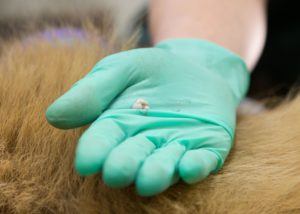
“I think he’s much younger than we previously thought,” Case said. “He appears to be about the same age as his “brother” from Alaska.”
Both bears, orphaned in the wild, now have a permanent home at Northwest Trek, which offers guests the opportunity to view and learn about native Northwest animals in natural habitats.
The Alaska bear was discovered near Nome in early spring and taken to Alaska Zoo in Anchorage for care. He is about 7 months old. Grizzly bear cubs are born in the den during the winter while their mothers are hibernating.
Case and a team of veterinary technicians and animal-care staff members spent about five hours giving the cubs their back-to-back physicals.
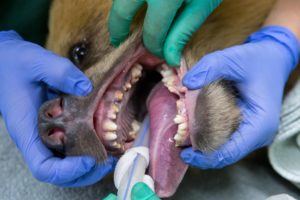
The care involved anesthetizing the cubs in their dens, transporting them to Northwest Trek’s Veterinary Clinic, and then performing comprehensive physicals that included abdominal ultrasounds, X-rays, collection of blood and urine samples, and an array of preventative immunizations against rabies, tetanus, distemper and other diseases.
The team was meticulous, taking weights and measurements, peering into eyes, ears and mouths, palpating abdomens, and running hands across already broad shoulders and growing hind legs to assess muscle mass and strength. A checklist helped them ensure nothing was missed.
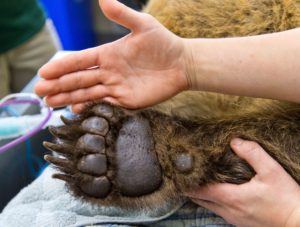
As Case examined the Montana cub’s ears, bear keeper Angela Gibson stood at his feet, carefully inspecting his paws and looking between each of his toes for any signs of disease or abnormality. There were none.
“This is a great opportunity for us to give him a thorough look-over,” Northwest Trek Zoological Curator Marc Heinzman said. “This gives us a good baseline,” he added. “If something is spotted down the road, we’ll know if it recently developed, or if it was something he had when he arrived.”
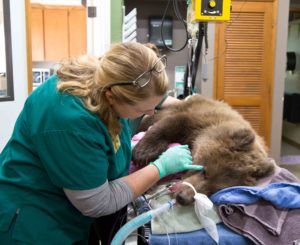
As Heinzman spoke, veterinary technician Deanna Edwards stood at the bear’s head, gently cleaning his ears. Veterinary technician Sara Dunleavy plucked up a stethoscope and listened to the bear’s rhythmic heart. A blood-pressure cuff was affixed to his left front leg, about where a human might have one placed on an arm. Above his head, a small machine showed his carbon-dioxide and oxygen levels.
The Montana cub’s fur is a striking two-tone. He sports a blondish-ginger body with a patch of black on his back, plus black legs and paws. His front claws are about 2 ½ inches long and will continue to grow. They’re perfect for digging a den, climbing a tree, clawing insects out of rotting bark in a log or teasing roots out of the ground, Gibson said.
“His muscles are developing,” she said. “He has strength in his legs.”
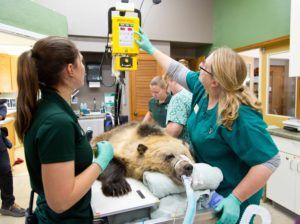
The exam for the Alaska cub, who weighed in at 96 pounds and is 48 inches from nose to tail, followed the same procedures as the physical for his “brother” from Montana. He is much darker, more an all-over chocolate brown, except for a half-moon-shaped white collar.
As a Coastal brown bear, the Alaska cub likely will be taller and heavier than the Montana cub by the time they’re full grown, Gibson said.
“They’re both in excellent health,” Case said when the physicals were concluded.
She credited Gibson, keeper Haley Withers and other Northwest Trek staff members for their intensive day-and-night care of the two cubs as they adapt to a new diet and taste the same kinds of seasonal foods they would eat in the wild.
The cubs remain behind-the-scenes in their dens as they continue to become more accustomed to their keepers, to a new diet and to one another.
No date has been set for their public debut. And they don’t yet have names. Keepers will offer up slates of names for each cub and members of the public will get an opportunity to vote for their favorites.
“We are thrilled to have these two healthy cubs at Northwest Trek,” Heinzman said. “As orphans, they needed a home. And we were fortunate enough to be able to provide them one where they will receive excellent care and help us teach generations of our guests about grizzly bears and the challenges the species faces in the wild.”
###
Northwest Trek Wildlife Park, accredited by the Association of Zoos & Aquariums, is a 725-acre zoological park dedicated to conservation, education and recreation by displaying, interpreting and researching native Northwest wildlife and their natural habitats. The wildlife park is a facility of Metro Parks Tacoma and is located 35 miles southeast of Tacoma off State Highway 161.
Media Contacts:
Kris Sherman, 253-404-3800; 253-226-6718 or kris.sherman@pdza.org
Whitney DalBalcon, 253-404-3637; 253-278-6343 or whitney.dalbalcon@pdza.org